
The House of Habsburg, also known as the House of Austria, is one of the most prominent and important dynasties in European history.
A queen consort is the wife of a reigning king, and usually shares her spouse's social rank and status. She holds the feminine equivalent of the king's monarchical titles and may be crowned and anointed, but historically she does not formally share the king's political and military powers, unless on occasion acting as regent.
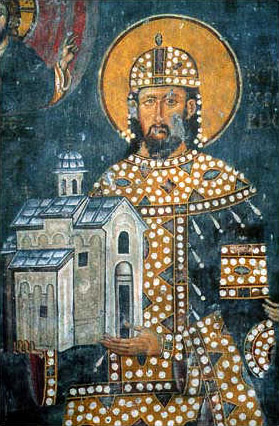
Stefan Dragutin, was King of Serbia from 1276 to 1282. From 1282, he ruled a separate kingdom which included northern Serbia, and the neighboring Hungarian banates, for which he was unofficially styled "King of Syrmia".

The King of Hungary was the ruling head of state of the Kingdom of Hungary from 1000 to 1918. The style of title "Apostolic King of Hungary" was endorsed by Pope Clement XIII in 1758 and used afterwards by all monarchs of Hungary.
Stephen I Kotromanić (1242–1314) was a Bosnian Ban from 1287 to 1290 jointly with Ban Prijezda II and 1290–1314 alone as a vassal of the Kingdom of Hungary.
Elizabeth the Queen Mother (1900–2002) was the consort of George VI and mother of Elizabeth II.

Archduke was the title borne from 1358 by the Habsburg rulers of the Archduchy of Austria, and later by all senior members of that dynasty. It denotes a rank within the former Holy Roman Empire (962–1806), which was below that of Emperor, and roughly equal to King, Prince-Archbishop, Grand prince and Grand Duke, but above that of a Sovereign Prince and Duke.

Charles Martel of the Capetian dynasty was the eldest son of king Charles II of Naples and Mary of Hungary, the daughter of King Stephen V of Hungary. The 18-year-old Charles Martel was set up by Pope Nicholas IV and the ecclesiastical party as the titular King of Hungary (1290–1295) as the successor of his maternal uncle, the childless Ladislaus IV of Hungary against whom the Pope had already earlier declared a crusade.
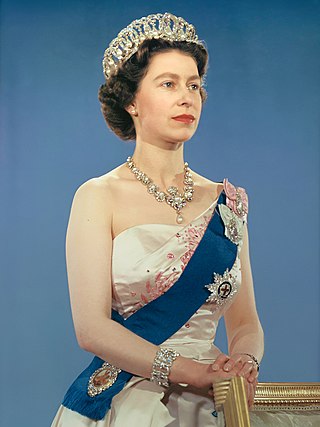
A queen regnant is a female monarch, equivalent in rank, title and position to a king. She reigns suo jure over a realm known as a kingdom; as opposed to a queen consort, who is married to a reigning king; or a queen regent, who is the guardian of a child monarch and rules pro tempore in the child's stead or instead of her husband who is absent from the realm, be it de jure in sharing power or de facto in ruling alone. A queen regnant is sometimes called a woman king. A princess regnant is a female monarch who reigns suo jure over a principality; an empress regnant is a female monarch who reigns suo jure over an empire.
A king-emperor is a sovereign ruler who is simultaneously a king of one territory and emperor of another. This title usually results from a merger of a royal and imperial crown, but recognises the two territories as different politically and culturally as well as in status. It also denotes a king's imperial status through the acquisition of an empire or vice versa.
Imperial and Royal Majesty was the style used by Emperor-Kings and their consorts as heads of imperial dynasties that were simultaneously royal. The style was notably used by the Emperor of Austria and by the German Emperor. The Austrian, German, and Bohemian monarchies were abolished in 1918 while the vacant throne of Hungary continued to exist until the 1940s.

Mary of Hungary, of the Árpád dynasty, was Queen of Naples by marriage to King Charles II. She was a daughter of Stephen V of Hungary and his wife Elizabeth the Cuman. Mary served as regent in Provence in 1290–1294 and in Naples in 1295–96, 1296–98, and 1302, during the absences of her husband.
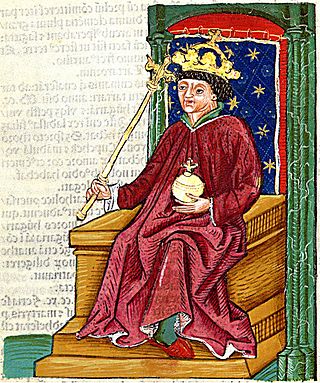
Andrew III the Venetian was King of Hungary and Croatia between 1290 and 1301. His father, Stephen the Posthumous, was the posthumous son of Andrew II of Hungary although Stephen's older half brothers considered him a bastard. Andrew grew up in Venice, and first arrived in Hungary upon the invitation of a rebellious baron, Ivan Kőszegi, in 1278. Kőszegi tried to play Andrew off against Ladislaus IV of Hungary, but the conspiracy collapsed and Andrew returned to Venice.

Gertrude Anne of Hohenberg was German queen from 1273 until her death, by her marriage with King Rudolf I of Germany. As queen consort, she became progenitor of the Austrian House of Habsburg.

The Capetian House of Anjou, or House of Anjou-Sicily, was a royal house and cadet branch of the Capetian dynasty. It is one of three separate royal houses referred to as Angevin, meaning "from Anjou" in France. Founded by Charles I of Anjou, the youngest son of Louis VIII of France, the Capetian king first ruled the Kingdom of Sicily during the 13th century. The War of the Sicilian Vespers later forced him out of the island of Sicily, which left him with the southern half of the Italian Peninsula, the Kingdom of Naples. The house and its various branches would go on to influence much of the history of Southern and Central Europe during the Middle Ages until it became extinct in 1435.
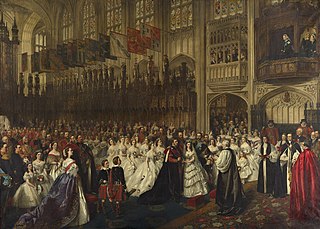
The royal descendants of Queen Victoria and of King Christian IX, monarchs of the United Kingdom (1837–1901) and Denmark (1863–1906) respectively, currently occupy the thrones of Belgium, Denmark, Luxembourg, Norway, Spain, Sweden and the United Kingdom. At the outbreak of the First World War their grandchildren occupied the thrones of Denmark, Greece, Norway, Germany, Romania, Russia, Spain and the United Kingdom. For this reason Victoria was nicknamed the "grandmother of Europe" and Christian IX the "father-in-law of Europe".
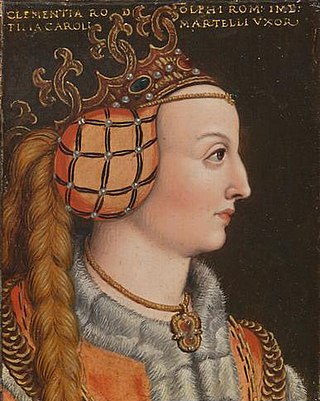
Clemence of Austria was a daughter of King Rudolph I of Germany and Gertrude of Hohenberg. She was a member of the House of Habsburg.
Elisabeth of Sicily (1261–1303) was Queen of Hungary by marriage to Ladislaus IV of Hungary.

Catherine of Hungary was a Queen consort of Serbia by her marriage to Stefan Dragutin. Catherine was the second daughter of Stephen V of Hungary and his wife Elizabeth, daughter of Seyhan, chieftain of the Cumans.

The grand title of the emperor of Austria was the official list of the crowns, titles, and dignities which the emperors of Austria carried from the foundation of the empire in 1804 until the end of the monarchy in 1918.































































